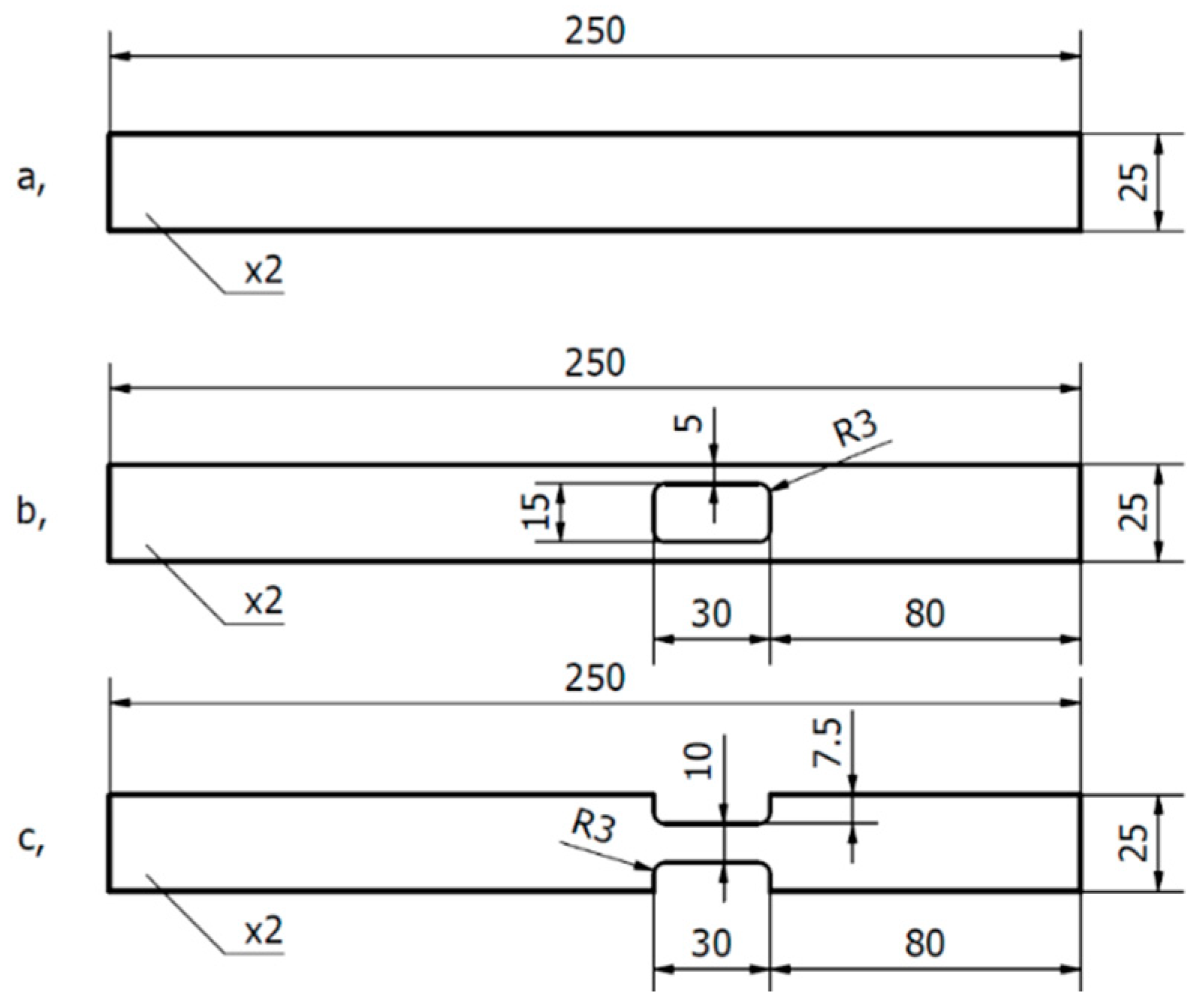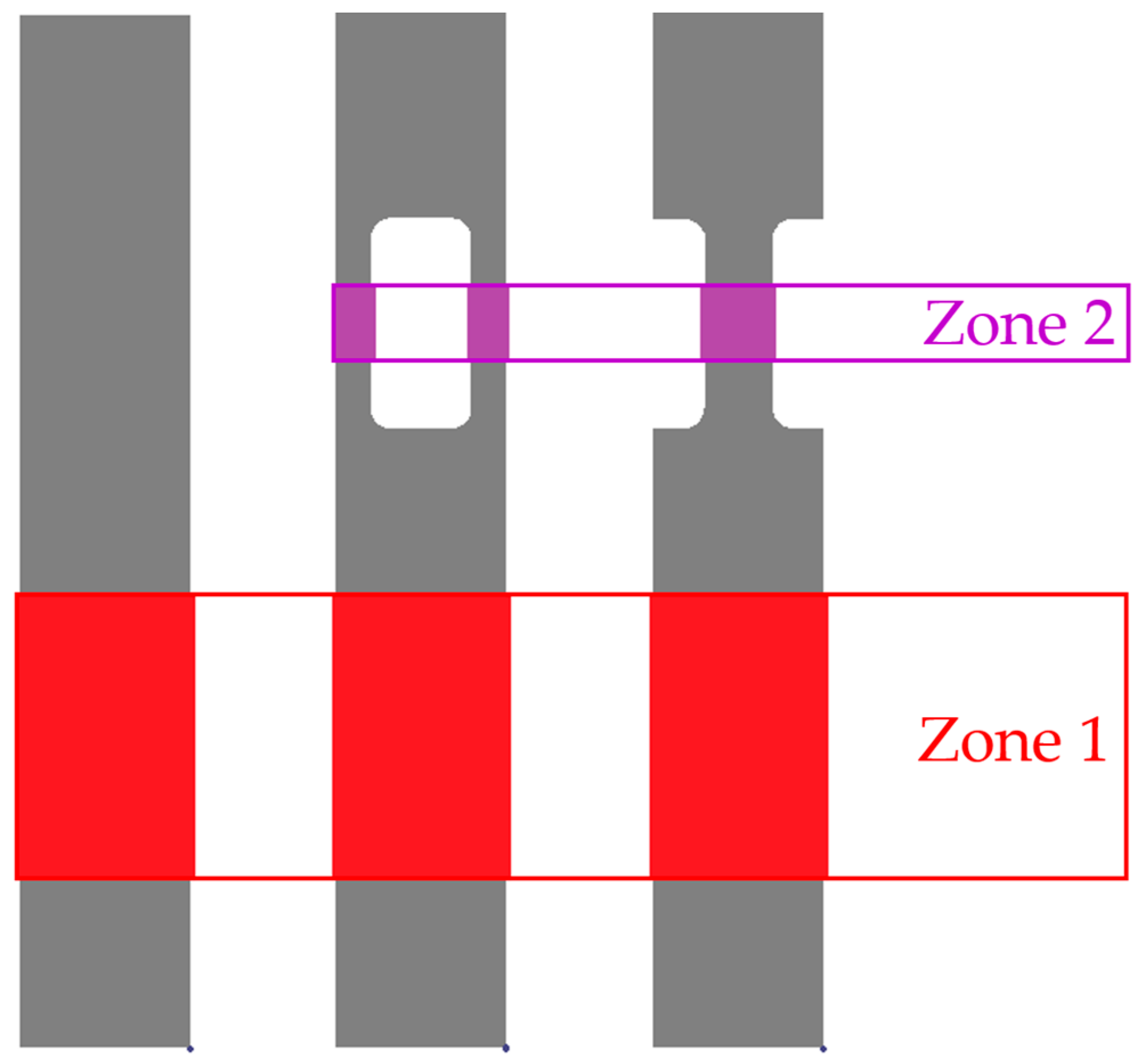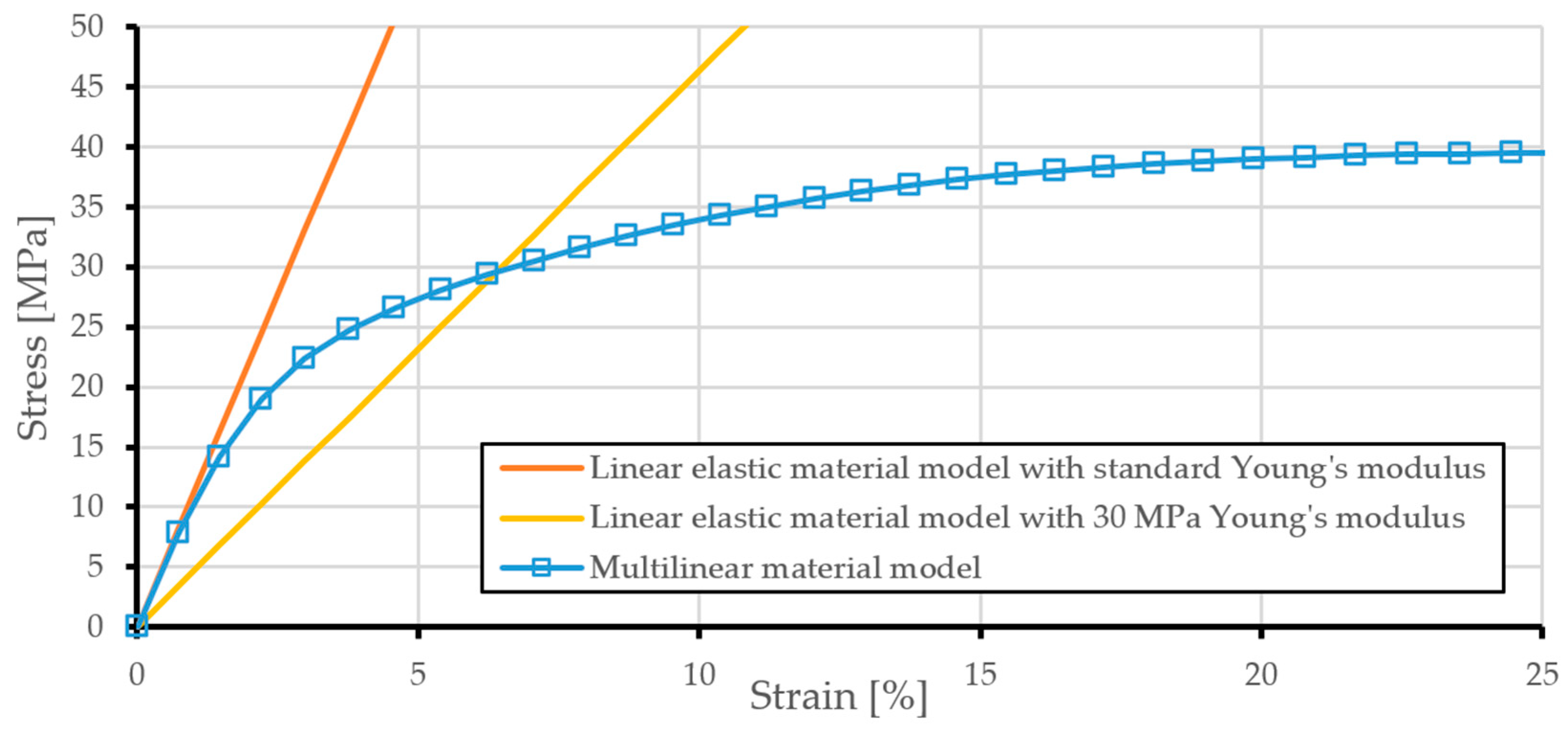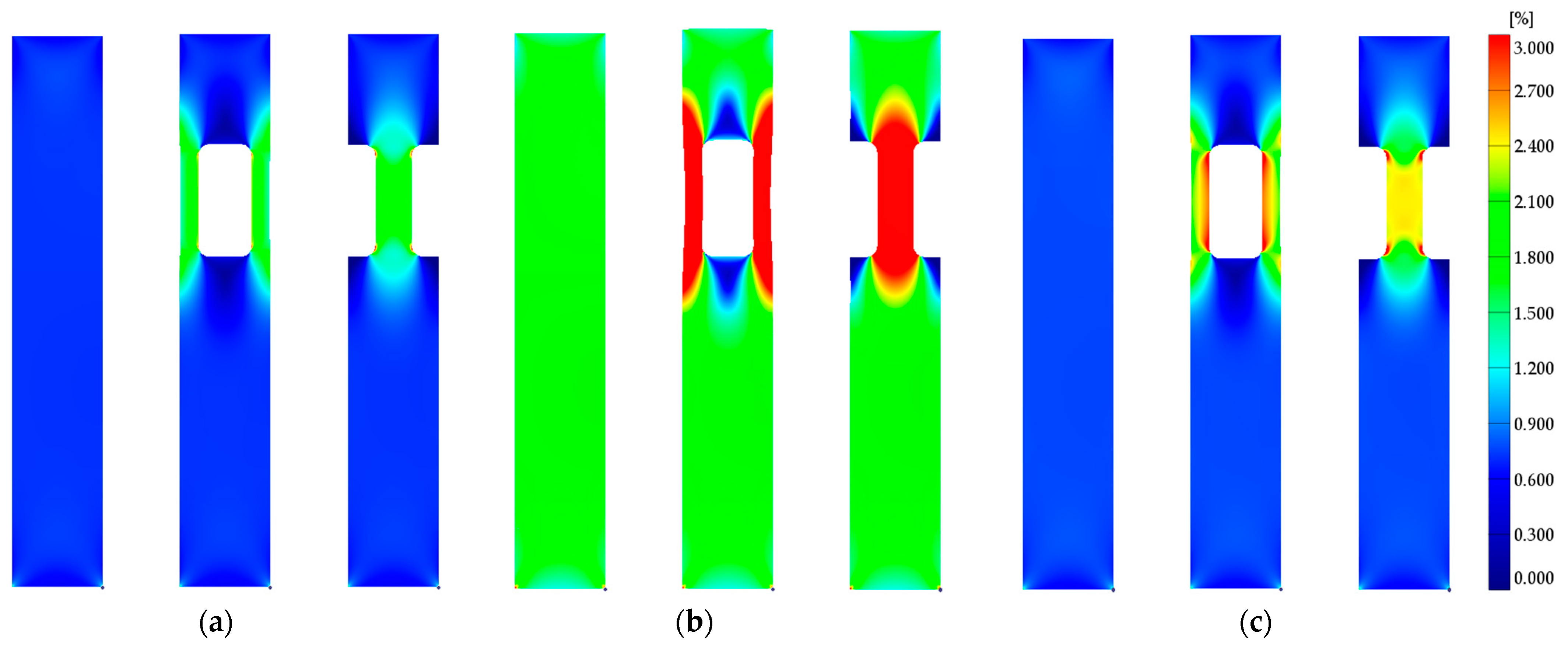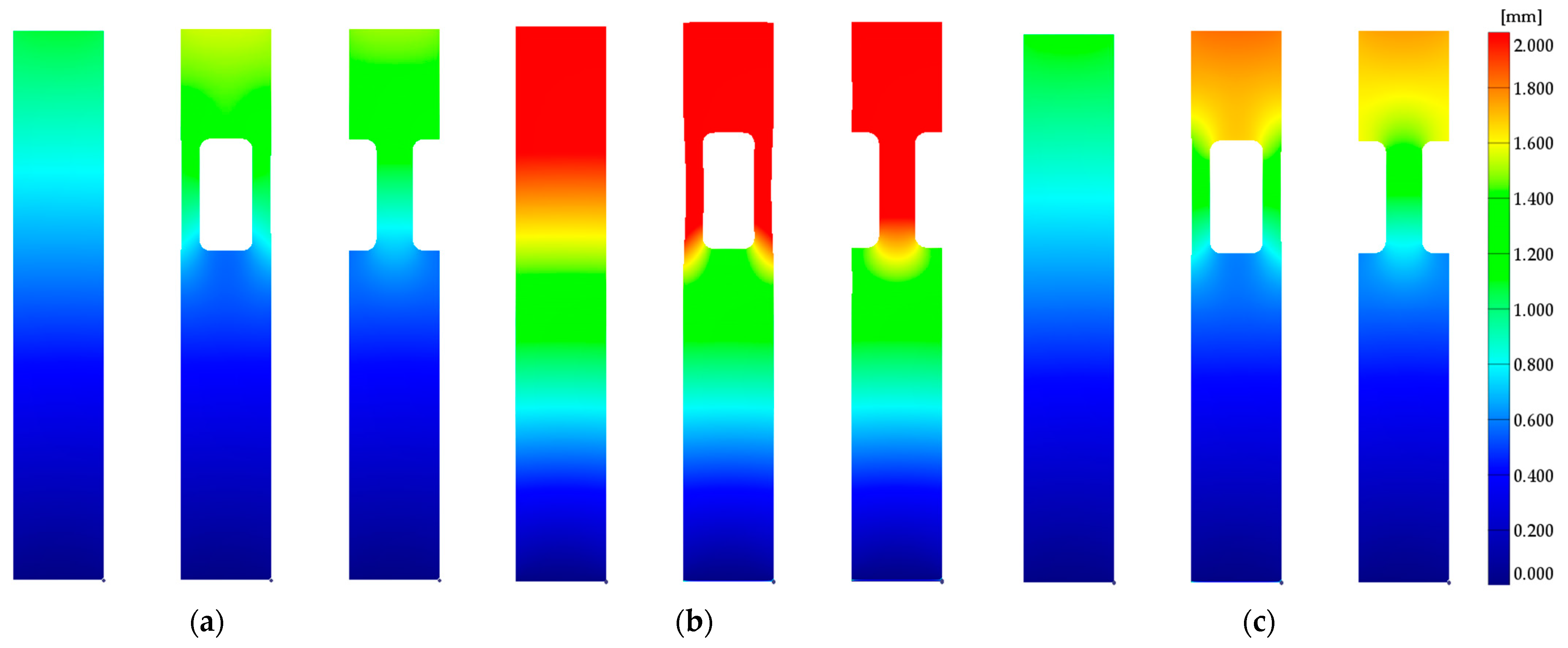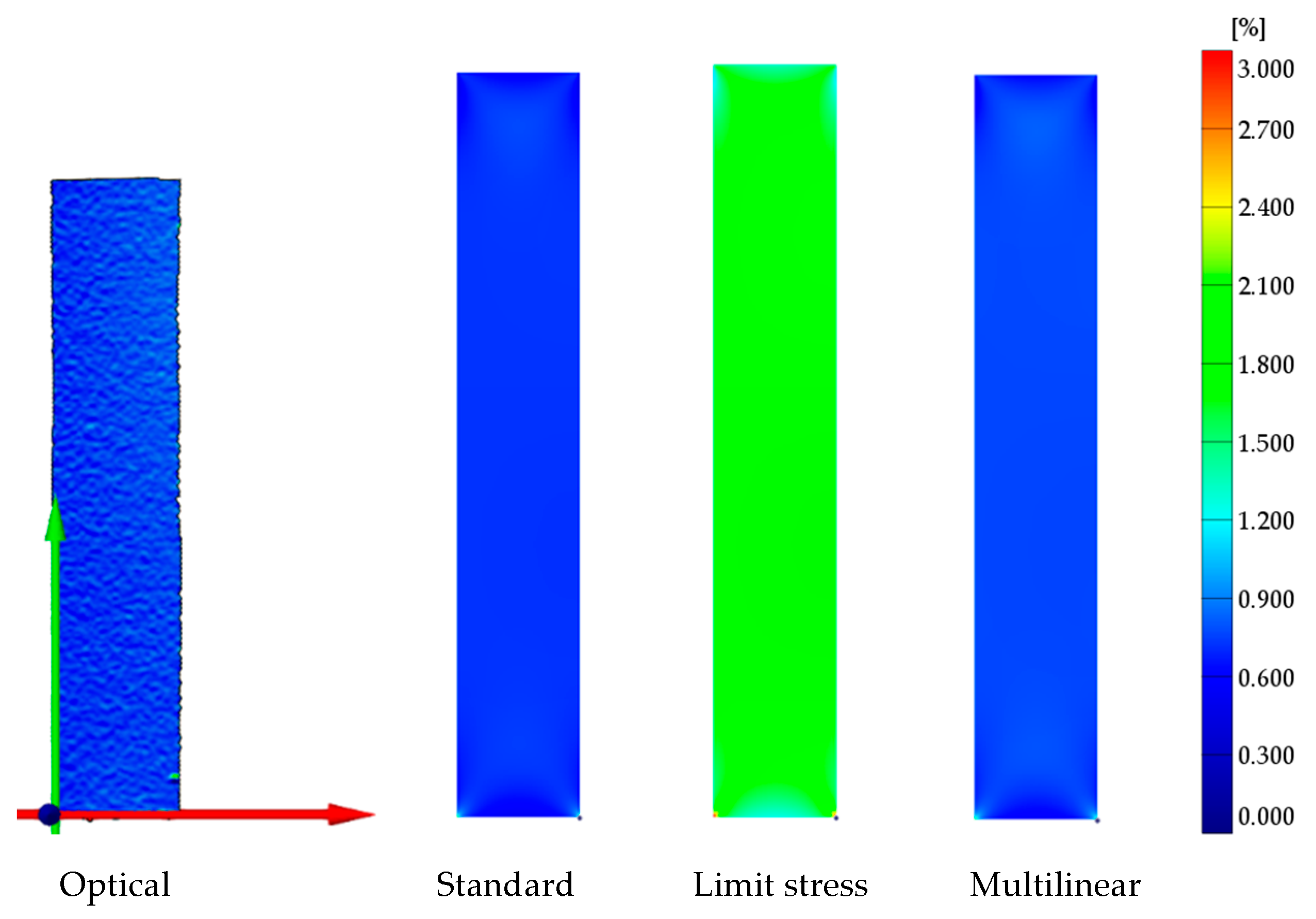1. Introduction
Polyamide 6 (PA6) is a widely used material in many fields of the industry. It serves as the matrix of many composite materials, and it is one of the most significant materials in 3D printing. As this and many other polymeric materials are more and more frequently being used, engineers come across these materials in product design. Finite element simulations are now an essential part of any product’s design phase. Different material models (elastic, plastic, viscoelastic, etc.) can simulate the material response of polymeric materials under certain types of loadings. Since this research is aimed to help the design process, the plastic behavior was not investigated.
There are many accepted ways to model polymeric materials in the elastic region. The simplest approach is the use of a linear elastic material model, which is generally used to model the small strain behavior of the material. For the modeling of higher deformations in the elastic strain zone, the usage of nonlinear material models is advised (bilinear, multilinear and hyperelastic). The bilinear material model uses two lines, and the multilinear material model uses more than two lines to describe the stress-strain relation. Hyperelastic models (Mooney-Rivlin, Ogden, etc.) have been developed for elastomers. However, these models can also be used to model plastics. In the case of thermoplastics, such as PA6, hyperelastic models do not provide more information than simple linear elastic material models, see in [
1].
The reason for the different modeling approaches is the nonlinear elastic relation between the stress and strain values of polymeric materials [
2,
3,
4,
5]. Generally, under small strains, the polymers behave linearly, but after a certain strain value, the linearity is lost, and the material starts to behave nonlinearly. The length of this section differs from polymer to polymer [
6]. Another aspect, which must be considered is the viscoelastic behavior (linear or nonlinear) in polymeric materials, so the stress-strain behavior of the material is time dependent. In the case of linear viscoelastic materials, there is a linear connection between the stress and strain values at any given time, while nonlinear viscoelastic materials present a nonlinear connection. These materials are often characterized by their stress relaxation and creep behaviors [
1,
6,
7,
8,
9,
10,
11]. PA6 is widely used as a structural element; thus, the time dependence of the material was neglected in our investigations because such elements are generally subjected to quasi-static loads. Alongside these properties, the mechanical properties of polymeric materials largely depend on the circumstances, such as the temperature, the testing rate, and the humidity [
12,
13,
14].
The material that will be investigated is the PA6, a semicrystalline thermoplastic. Its stress-strain curves in the elastic region begin with a linear section, then transition into nonlinearity as the stresses increase [
15,
16]. The water content and the temperature also have a significant effect on the mechanical properties [
14,
16,
17,
18]. Testing rate dependence and creep are also present in the material [
15,
19]. To avoid measurement inconsistencies, all specimens have to be prepared from the same sheet of plastic, stored under the same conditions, and tested at the same rate.
The multilinear and viscoelastic material models are able to accurately model the nonlinear elastic behavior of the material, but the creation of them requires either load case-specific measurement data or, in the case of more complex loading, measurement data from different measurement methods [
1,
11,
20,
21,
22]. The linear elastic material model, on the other hand, only requires Young’s modulus or the shear modulus and the Poisson’s ratio of the material [
1]. These data are broadly available, and the creation of the material model is simpler, but the effectiveness of these models is varied [
6].
The different finite element simulations can be validated by laboratory experiments using full-field optical measuring systems, which work based on the digital image correlation (DIC) method. These systems create pictures during the measurement and compare the changes of the required stochastic pattern to calculate various measurements, such as deformation and strain. There are two-dimensional and three-dimensional DIC measuring systems. This equipment is widely used in material and structure testing, because of the ease of setting up a measurement and because of its ability to measure along the whole surface instead of only between two points [
23,
24]. In material testing, it is widely used to evaluate the different local strains and deformations on the surface of the specimen [
25,
26,
27]. The results from these experiments can be directly compared to the results of accurately created finite element simulations [
5,
11,
28,
29,
30,
31]. By this comparison, the different material models can also be validated, and the most suitable ones can be selected [
32,
33].
The comparison between the simulations and the optical measurements not only provides information about the most suitable material model, but when tested at both lower and higher, but still elastic strains, it also outlines the limits and capabilities of each material model. This work is aimed to find out the effectiveness of the linear elastic material models when modeling PA6 by comparing them to a nonlinear elastic material model and validating all results using advanced full-field measurement systems. This material was chosen because its stress-strain curves have a significant amount of linearity and nonlinearity as well, and it is widely used in many fields of the industry. During the measurements, only the elastic properties were tested, the measurement method was set up in a way to avoid any other factors, such as testing rate dependence, water content dependence, and viscous properties, to simulate the effect of a quasi-static load. By finding out the limits of the linear elastic material models when modeling nonlinear elastic materials under quasi-static loading, the possibilities of these material models’ usage in the industry can be determined, thus shortening the time and effort required to set up a finite element simulation for such materials. During the product development phase, only the elastic region of the material is in focus because any kind of failure has to be avoided.
4. Conclusions
This article investigated the capabilities of linear elastic material models when modeling a nonlinear elastic material under quasi-static loading. First, a tensile test was performed by the ISO 527-2 standard to ensure that the defined material models were as accurate as possible. During the evaluation of the standard measurement results, the Young’s modulus calculated in the ISO 527-2 standard’s recommended 0.05–0.25% strain interval showed higher than 10% error values. Thus, the Young’s modulus for the material was determined at the 0.25–0.45% strain interval with a 3% error. Based on the material testing results, a linear elastic material model defined by the standard Young’s modulus, a linear elastic material model with Young’s modulus calculated until the limit stress, and a multilinear material model was chosen for the finite element simulations. The models were then simulated using three different specimen geometries. After the simulations, the laboratory measurements were performed using the GOM Aramis full-field optical measurement system. The results of the comparison showed that the specimen geometries and the method of comparing the optical measurements are accurate and usable for the validation of material models.
The comparison between the three material models and the optical measurements showed that the linear elastic material models with the standard Young’s modulus can be used for the modeling of the small strain behavior of nonlinearly elastic materials. In the case of the PA6 material, the limit of modeling is 0.96% strain. It is interesting to note that during comparison, this material model showed the same 3% error that was seen when calculating the standard Young’s modulus of the material, meaning that the 3% error could exist in the production of the sheet material and not in the modeling itself. When evaluating the deformations, on the other hand, the linear elastic material models never provided accurate results. This could be due to the fact that near the grips, increased strain values occur, which exceed the modeling limit of 0.96% strain. This results in increased local deformations, which the material model is not able to account for.
Overall, the linear elastic material model with standard Young’s modulus could be used in the industry to model any polymeric materials’ small strain behavior when the product is under quasi-static loading, and the goal is to find the average strain or stress values of a part. In these cases, the usage of this material model can shorten the design process because setting up such a model is a shorter process than creating a multilinear material model, and the data required for this model is vastly available. In contrast, the stress-strain curves required to create the multilinear material models must be obtained via standardized material testing, which is a costly and time-consuming process. Although, to evaluate deformations, the multilinear material models are still the more accurate choice.

